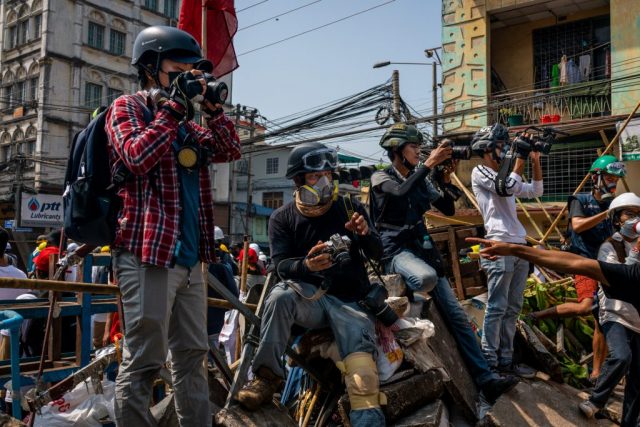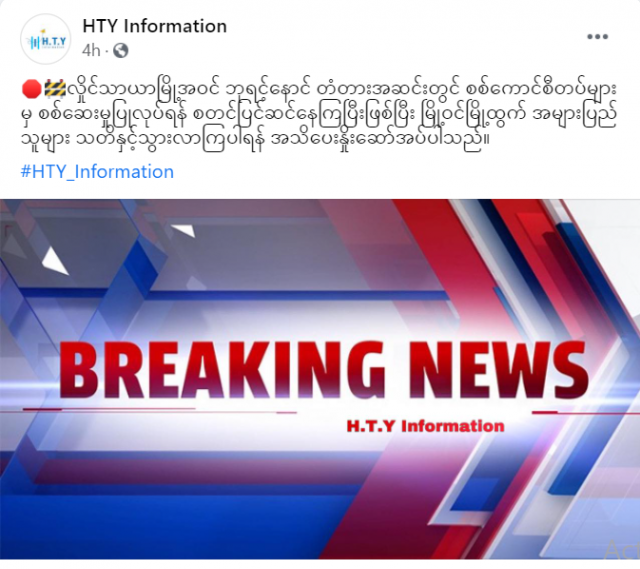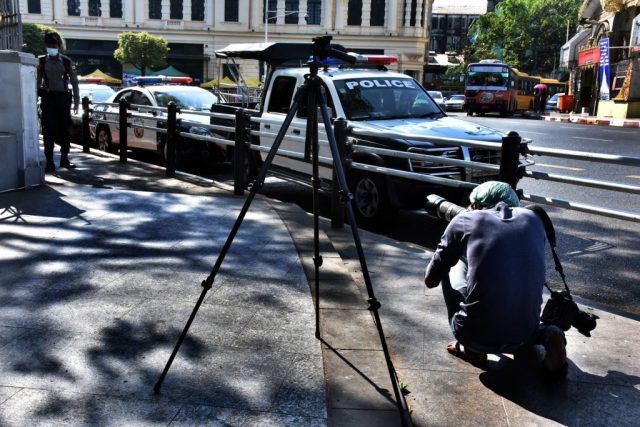Journalism goes local as the junta shackles national media
28 May 2021


Journalists covering an anti-coup protest in Yangon’s Hlaing Township on March 2 are seen moments before a crackdown by security forces. (Frontier)
Amid the near-destruction of Myanmar’s media industry, nimble township-based outlets have sprung up to meet the constant demand for local news about the nationwide uprising.
By FRONTIER
First thing each morning, 26-year-old Ko Zaw Oo checks his online messages for recent news or tip-offs about protests and crackdowns in his home township of Hlaing Tharyar, a densely populated factory district on the north-western outskirts of Yangon.
“If something interesting is happening, I’ll go and see for myself,” said the 26-year-old. “Otherwise, I’ll roam around [Hlaing Tharyar] and find news to post about.”
Zaw Oo, who asked that his real name not be used to protect his safety, was telling Frontier about his daily routine as the editor and chief reporter for HTY (Hlaing Tharyar) Information. He founded the Facebook page and website on March 5 to provide a regular feed of reliable news about developments in the township.
Formerly an IT professional, with no previous experience or training in media, he said he had “never imagined [he’d] be doing this kind of work”. He came up with the idea for HTY Information when posts from his personal Facebook account following the February 1 coup went viral, alerting him to the huge appetite for local news amid a nationwide uprising. His news outlet has since proved popular, with more than 167,000 followers and posts that are frequently shared thousands of times.
Initially working as a team of one, Zaw Oo tracked the anti-coup demonstrations as they grew in scale and confidence in the township – with the participation of tens of thousands of factory workers from what is the hub of Myanmar’s garment industry – until a brutal crackdown by security forces on March 14 prompted many residents to flee to family homes in the countryside.
Although the crackdown all but crushed the local protest movement, it motivated Zaw Oo to keep reporting as resistance to military rule went underground, many of the township’s internal migrant workers eventually returned from rural areas, and the junta struggled to assert its authority over local communities and chase down dissidents. From early April, he was joined by 10 volunteer reporters, enabling more comprehensive coverage.
Zaw Oo said the bloodshed of March 14 showed him that many crucial events in Hlaing Tharyar would go unreported without local outlets like his own.
“I saw a lot of people die in the crackdown. I was able to broadcast some of the violence live, but a lot of mainstream media couldn’t report what had happened in Hlaing Tharyar,” he said, adding that the roughly 60 deaths reported by national outlets was significantly below the true death toll, which he put at more than 100 based on local civil society sources.
“Many reporters were unable to reach Hlaing Tharyar that day,” Zaw Oo said. “That’s when I resolved to [continue to] regularly report what is happening in the township.”
He pointed out that the March 14 massacre happened shortly after the junta seriously escalated its assault on the media, with a ban on five major media organisations announced on March 8. Most of these outlets responded with defiance; Myanmar Now, Democratic Voice of Burma, Mizzima and Khit Thit Media have continued to publish and broadcast online. The exception was 7Day News, the country’s highest circulation newspaper, which immediately stopped printing and scrubbed its online presence.
In addition to the bans, which have since been extended to Kachin State-based Myitkyina Journal and 74 Media and the eastern Shan State-based Tachileik News Agency, the junta has raided several newsrooms and arrested more than 80 journalists, over 40 of whom are still in custody, including Frontier’s managing editor, Danny Fenster. Meanwhile, other newspapers such as Myanmar Times and The Voice have decided to fold voluntarily, due to a post-coup climate that is hostile to both business survival and press freedom.
These attacks on media freedom have decimated a news industry that blossomed after the lifting of print censorship in 2012. In their place have arisen hyper-local, township-based media outlets like HTY Information. Covering the breadth of Myanmar, from Yangon to Chin State to Magway Region and elsewhere, they have met a surge in demand for local news as protests and strikes continue to be met with deadly force – an environment where, for ordinary people, staying informed is crucial to staying alive.
Some of these small, nimble outlets are run by experienced journalists and offer miniature versions of conventional news articles on websites and Facebook pages. However, many more have been started by untrained youth, who stick to social media and blur the lines between journalism and activism. As well as documenting events, they tip local residents off to police and army clampdowns, and also help to coordinate protests and fundraising for striking government workers in the Civil Disobedience Movement – a kind of community media tailored to the post-coup times.
“This is a new type of information stream for the people; citizen journalism is filling the gap in professional media coverage,” said U Myint Kyaw, a member of the Myanmar Journalist Network and a media trainer who resigned from the national Press Council shortly after the coup.
But despite attracting tens of thousands of readers, who they sometimes appeal to for donations, several of the local outlets told Frontier they’re struggling to meet their meagre operating costs in an increasingly cash-strapped economy. Their reach has also been curbed by a ban on mobile internet in place since mid-March.
More seriously, several editors and reporters told Frontier they’re being hunted down by the security forces, just like their counterparts in national media organisations. While this proves the impact of these local outlets, some are struggling to operate while in hiding or on the run.

A May 28 Facebook post by Hlaing Tharyar-based outlet HTY information alerts residents to checks by security forces on a bridge leading into the township from central Yangon.
‘The impact was huge’
U Wai Lin, a co-founder of the Thingangyun Post, is one of the few local media pioneers with an extensive background in journalism. The 30-year-old stressed that his outlet, which serves residents of Thingangyun Township as well as neighbouring townships in Yangon, fills a gap vacated by national media by marrying professionalism with a commitment to telling local stories.
“Mainstream media is no longer widespread and township-based media outlets like ours have become reliable sources of information for the public,” said U Wai Lin, who launched the Thingangyun Post with a colleague in 2019 after a decade in journalism.
“At that time, very few people knew about us, but we have gained more readers since the coup,” he said, alluding to the Facebook page’s more than 112,000 followers.
Wai Lin said the Thingangyun Post, which operates as a team of three journalists, was the first media outlet to report a February 15 raid by the security forces on a residential compound in the township that housed Central Bank employees, many of whom had joined the CDM.
“We arrived there early that day,” Wai Lin said. “Later, when we broadcast the situation live on Facebook, others came to know what was happening and better-known media arrived. Since then, our page has become very popular in Thingangyun.”
He said the Thingangyun Post’s coverage of the raid allowed it to fulfil two functions that are crucial to the mission of most township-based outlets: keeping residents informed, and bringing local incidents to national attention.
“The impact was huge,” Wai Lin said. “Many people came to show support for the striking Central Bank staff.”
But away from Yangon, where most of the remaining national outlets are based, the need to capture and draw attention to local incidents is even greater.
“In our city, there were protests and demonstrations and a lot of people were arrested by the military, but there was no news about it in the mainstream media,” said Ko Min Naung, who lives in the famous ruby mining centre of Mogok, in a mountainous area of northern Mandalay Region. “That’s why we established the Mogok Information Group.”
Min Naung, a pseudonym, is one of nine 20-year-olds in the town who founded the outlet, which has a Facebook page with more than 25,000 followers and a Telegram channel.
By mid-May, the Mogok Information Group had reported 11 deaths and more than 100 arrests in the area, “but I was unable to find any [other] media reports about this,” Min Naung said.
The Facebook page mostly posts real-time updates and warnings about bombings, arrests and army mobilisations, which have become common in Mogok in recent weeks. With most posts being less than 100 words, and with a staunchly activist stance, little of the group’s output meets a conventional definition of journalism.
But for the group’s founders, the need to provide the people of Mogok with potentially life-saving information in an environment of widespread dissent easily outweighed any lofty considerations of media professionalism.
“The main thing is for the protesters in the town to be able to run when the army and the police are coming,” explained Min Naung.
“We had never written a news story, or studied journalism,” he said. “We try to write by ourselves because we want to tell the news in our town.”
A similar amateur passion had inspired the young founder and administrator of Myingyan News, a Facebook page with more than 70,000 followers.
“It was hard for me to write news but I kept trying and now people know about the military’s abuses in our town,” said 20-year-old Ko Lin Aung, a pseudonym.
He reports on Myingyan Township alongside 20 other locals. In a sign of the outlet’s activist bent, they are drawn from night watch groups that patrol neighbourhoods each night after the curfew, to protect community members from the junta’s security forces.
The dusty Dry Zone township in Mandalay Region has seen armed resistance in addition to peaceful street protests, and the junta has cracked down brutally as a result. Lin Aung claims his group’s reporting has brought this violence to wider attention, with larger news organisations using Myingyan News as a source.
“When mainstream media learned about us, they interviewed us about the situation in Myingyan,” he said. “We achieved our goal.”

A journalist at work near Sule Pagoda in central Yangon on February 4, just three days after the military coup, which has resulted in a widespread crackdown on media. (Frontier)
‘We have to be brave’
The founders of these township-based outlets said their work depends on the collaboration of readers.
“Almost every day, regular readers are sending messages to the [Facebook] page’s inbox to confirm news,” said Zaw Oo of HTY Information.
But even with this support, which also comes in the form of donations via mobile wallets, providing daily news has been a financial challenge for these outlets, who don’t seek revenue from advertising or other commercial sources.
“I have no income; every cost is covered from my pocket,” Zaw Oo said, adding that since HTY Information was established in early March, its expenses – which include buying cameras and covering phone bills and taxi fares, as well as occasional reporting fees to staff – have exceeded K3 million (US$1,820).
There’s a similar problem at the Thingangyun Post, which Wai Lin said costs up to K20,000 a day to produce, due to similar expenses. “We cover the costs ourselves,” he said.
The reach of their online news dispatches has also been curtailed by the junta’s internet restrictions. The block on mobile internet imposed in mid-March has been a particular blow, because the large majority of Myanmar people access the web via smartphones. However, the junta’s gradual white-listing of apps and websites since April has, deliberately or otherwise, made the work of most township media accessible via VPNs.
For Yangon-based HTY Information and the Thingangyun Post, the mobile internet ban has been less of a problem. This is thanks to the relatively wide availability in the city of fibre internet, which the junta has left open despite blocking wireless broadband.
Wai Lin said readership and engagement with Thingangyun Post content had “decreased a bit” since the ban, but he believed it would remain widely read for as long as fibre connections remain open.
“If they cut [fibre], we can’t work,” he said. “We can’t say the junta won’t do this, and I’ve made plans to produce a printed paper in our township if it happens.”
In small towns and villages, however, people tend to lack any access to fibre internet.
“In urban areas of Mogok, a lot of homes have fibre internet, but rural areas have no access to it,” said Min Naung of the Mogok Information Group. “So, we printed a weekly newspaper and distributed it in some villages.”
However, Min Naung and his colleagues only distributed two editions of the paper in the latter half of April before the junta’s gradual whitelisting of websites made the group’s content available via mobile internet again. “If mobile internet is [entirely] cut again, we will go back to producing the print paper,” he said. “We won’t give up.”
Besides limited internet and finances, there is a still-greater threat to the survival of township-based media.
Wai Lin of the Thingangyun Post put it bluntly. “The main danger is the junta,” he said.
In the first and so far only known arrest of a township media practitioner, on April 24, soldiers and police seized the editor-in-chief of the Thanlyin Post, Ma Tu Tu Thar, 49, in a raid on her home in Yangon’s Thanlyin Township during which they also took away her 18-year-old son, brother, and a friend.
Before this incident, in early April, Wai Lin realised he was being watched, so he moved from Thingangyun to a secret location in South Okkalapa Township.
But even there, the junta seemed to be tracking him.
“A neighbour [in South Okkalapa] told me a man in civilian clothes had asked about us three times,” he said of himself and a colleague, adding that they had since moved to another hiding place in Yangon.
But even if Wai Lin is safe in hiding, his loved ones might not be. As the junta has grown increasingly desperate to impose order, its troops have taken to detaining the relatives of fugitives, seemingly regardless of whether these relatives had any role in assisting them.
“I am worried that my family members will be arrested,” he said of his parents and two brothers, who remain at his original Thingangyun address. Wai Lin added that he was “not alone” among local journalists in feeling that he was putting relatives at risk.
Meanwhile, in Hlaing Tharyar, Zaw Oo is confident the junta doesn’t know his identity. However, readers have warned him that police and soldiers are searching the township for whoever is behind HTY Information.
He said he came dangerously close to being caught in early April, when his live reporting on the aftermath of a bomb blast at the administration office for the township’s seventh ward brought security forces rushing to the scene.
“I was still at the site of the bombing when they came looking for me. I ran away fast; I was very scared,” he said, adding that he had since gone into hiding elsewhere in the township.
“My media outlet is successful, which means I’m in greater danger,” he said.
The need to constantly evade the security forces and their informers has also compounded the problems created by the internet restrictions. Wai Lin and Zaw Oo say their hiding places lack fibre internet, meaning they have needed to venture outside to post news, putting themselves and others in great danger in the process.
“Sometimes teashops are my newsroom. Sometimes my friends’ homes are my office,” said Wai Lin.
But despite these difficulties and the daily risks they face, Zaw Oo said that he and other “citizen journalists” owed it to their communities to keep reporting.
“We have to be brave now,” he said. “If we cannot fulfill our media roles, no one will know about the military’s atrocities.”
Original Post: Frontier Myanmar
Announcements
28 February 2025
Asian NGO Network on National Human Rights Institutions , CSO Working Group on Independent National Human Rights Institution (Burma/Myanmar)
Open letter: Removal of the membership of the dis-accredited Myanmar National Human Rights Commission from the Southeast Asia National Human Rights Institution Forum

Progressive Voice is a participatory rights-based policy research and advocacy organization rooted in civil society, that maintains strong networks and relationships with grassroots organizations and community-based organizations throughout Myanmar. It acts as a bridge to the international community and international policymakers by amplifying voices from the ground, and advocating for a rights-based policy narrative.